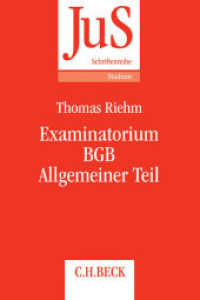- ホーム
- > 洋書
- > 英文書
- > History / World
Full Description
The modern research university originated in Europe in the second half of the nineteenth century, largely due to the creation and expansion of the teaching and research laboratory. The universities and the sciences underwent a laboratory revolution that fundamentally changed the nature of both. This revolutionary development began in chemistry, where Justus Liebig is credited with systematically employing his students in his ongoing research during the 1830s. Later, this development spread to other fields, including the social sciences and the humanities. The consequences for the universities were colossal. The expansion of the laboratories demanded extensive new building programs, reshaping the outlook of the university. The social structure of the university also diversified because of this laboratory expansion, while what it meant to be a scientist changed dramatically. This volume explores the spatial, social, and cultural dimensions of the rise of the modern research laboratory within universities and their consequent reshaping.
Contents
List of Figures and Tables
Preface
1. The Joint Emergence of the Teaching-Research Laboratory and the Modern University: An Introduction ( Klaas van Berkel and Ernst Homburg)
PART I: THE LABORATORY REVOLUTION: ORIGINS AND IMPACT
2. Origins and Spread of the 'Giessen Model' in University Science (Alan J. Rocke)
3. The Laboratory Ethos, 1850-1900 (Frans van Lunteren)
PART II: LABORATORY NETWORKS
4. Chemistry in Zürich, 1833-1930: Developing the Teaching-Research Laboratory in the Swiss Context (Peter J. Ramberg)
5. Island Kingdoms in the Making: The New Laboratories and the Fragmentation of Dutch Universities c. 1900 (Klaas van Berkel)
6. A Fertile Ecosystem: University Chemical Laboratories and their Suppliers in Fin-de-Siècle Paris (Pierre Laszlo)
7. Fighting for Modern Teaching and Research Laboratories in Norway: The Chemistry Laboratory in Political Dispute Around 1920 (Annette Lykknes)
8. Religion and the Laboratory Revolution: Towards a Physiological Laboratory at a Calvinist University in the Netherlands, 1880-1924 (Ab Flipse)
PART III: LABORATORY VALUES
9. Aspects of the Social Organization of the Chemical Laboratory in Heidelberg and Imperial College, London (Peter Morris)
10. Of Growing Significance: The Support Staff in the Laboratories and Institutes of Utrecht University During the Interwar Period (Bas Nugteren)
11. A Revolution in Genetics at Gendered Experimental Venues in Cambridge and London, 1890-1930 (Ida H. Stamhuis)
12. Serialized Laboratories: Laboratory Journals and the Making of Modern Science and Scientific Publishing, 1840s-1950s (Dorien Daling)
13. Images of the Laboratory in the Popular Press (Geert Vanpaemel)
Acknowledgements







